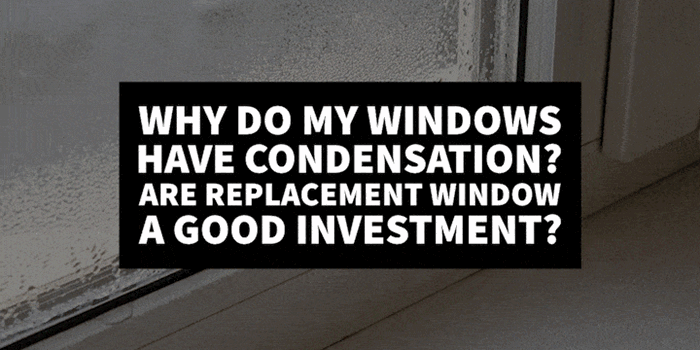Why Do My Windows Have Condensation? Are Replacement Window a Good Investment?

During colder seasons, many of us notice condensation forming on the windows of our homes. This phenomenon manifests itself when humidity comes into contact with a cooler surface - your windows, in this case. Most times, this can be shrugged off as a harmless side-effect of the cold, but we should know that there are different types of condensation, each of which should be taken in a different light. Condensation can either form on the outside of your windows, on the inside of your windows, or in between window panes.
Think of these as the Good, the Bad, and the Ugly types of window condensation. In this post, we’ll explore why windows have condensation, the different types of condensation we can experience, and when newly installed or replacement windows are a good investment idea.
Why Windows Have Condensation and Their Different Types
Because different types of condensation have other causes and effects, it’s essential to understand what they are and signify.
Condensation outside your windows
When condensation forms on the exterior surfaces of your windows, it’s a sign that everything is working as it should be. It means that your windows are doing the job of preventing heat loss from your home effectively.
While you might not like the sight of condensation on your windows, it is harmless and will clear up naturally as the air outside warms up. Still, it would be best to regularly check the frames and sills of your windows to ensure that moisture isn’t collecting inside your walls, which might lead to dampness and mold growth.
Condensation inside your windows
When the days start to grow cold, the difference between the temperature inside your home and that outside your house might lead to condensation inside your windows. Usually, you’ll notice this in the form of steaming or fogging, as you might see when you take a hot shower. The trouble here is that when the humidity inside your home condenses on the inside of your windows, it creates an extensive breeding ground for mold and mildew.
These growths have the potential to cause various health issues for you and your loved ones, especially for children, the elderly, or those who have previous respiratory problems (asthma, emphysema, allergies, etc.).
Over time, this water damage can lead to rotting window frames and damage your home’s structural integrity. Such damages might cost you thousands of dollars to remedy if left unchecked.
Condensation in between your window panes
Something is wrong if you ever notice condensation between the panes of a double-glazed or triple-glazed window unit. When fogging occurs here, the windows are not doing their job, most likely because the seals designed to keep the insulating air in the space between these panes have failed, rendering the windows virtually useless.
How to Minimize Condensation
As we’ve covered above, there’s not much you can do to rectify the situation where double-glazed windows are concerned aside from replacing them, and condensation outside your home shouldn’t cause you much concern.
For condensation inside your home, however, there are various measures you can take to reduce the humidity in your home and remedy the situation. These include:
- Turn down your thermostat: The warmer the temperature in your home, the greater the condensation you’ll experience. Turn down your thermostat temperature to mitigate the issue.
- Ventilate your home: Open up your windows to let the humidity gradient between the inside of your property and the outside equalize.
- Use extractor fans: Cooking, showering, and bathing are some of the biggest contributors to humidity in a home, and using extractor fans where these activities take place will go a long way in minimizing humidity and condensation.
- Use a dehumidifier: Automatic dehumidifiers or dehumidifier boxes that use damp crystals can effectively solve your problem.
- Dry your clothes outdoors: When we dry our clothes indoors after running them through the washing machine, the moisture being released directly contributes to the overall humidity. This situation can be avoided by hanging clothes to dry outside.
When are Replacement Windows a Good Investment?
The decision to replace or upgrade your windows due to the effects of condensation will depend on the extent of the damage in question and the type of windows being considered.
For double-glazed windows, condensation will likely result from failing windowpane seals and require expert window replacement. In the case of single-pane windows, try implementing the suggestions we’ve mentioned above, and consider calling in the professionals if nothing you’re doing seems to work.
Remember to keep a keen eye on any potential rot, mold growth, and window frame deterioration of any sort, as these factors may also influence the effectiveness of your windows.
Final Thoughts
One of the most prominent culprits of high energy costs in American homes is heat loss through inefficient window fittings. An excellent way to gauge the effectiveness of your windows is by observing the type and volume of condensation that forms on them. If none of the measures we’ve outlined above resolve your condensation issues, you might need urgent window replacement.
Couto Construction has proudly served the residents of Massachusetts, Cape Cod, and Rhode Island. If you need expert, dedicated, and experienced window installation and replacement services, make Couto Construction your first call. You won‘t regret it!